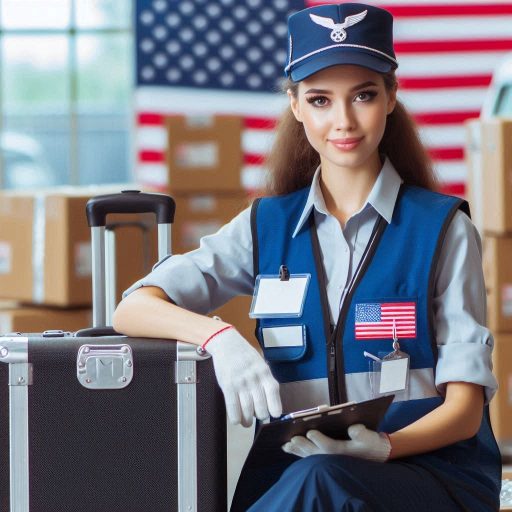Introduction
Safety in the workplace is crucial for both employees and employers.
For baggage handlers, the stakes are particularly high.
These workers operate in a fast-paced environment, often handling heavy luggage and working near moving vehicles.
This combination of factors makes safety a top priority.
Baggage handlers face numerous risks daily.
Lifting heavy bags can lead to serious injuries, including strains and sprains.
Poor lifting techniques can exacerbate these risks, affecting long-term health.
Workers must understand proper methods to reduce the chance of injury.
The presence of heavy equipment further complicates the safety landscape.
Forklifts, conveyor belts, and tugs are common in airports.
These machines can pose significant hazards if operators do not follow safety protocols.
Awareness of surroundings is essential to avoid accidents.
Weather conditions can also create hazardous situations.
Rain, snow, and ice can make surfaces slippery.
Handlers must be vigilant when transporting luggage in inclement weather.
Proper footwear can help reduce the risk of slips and falls.
Additionally, baggage handlers work in busy areas with a constant flow of passengers and vehicles.
This high level of activity can increase the likelihood of collisions.
Workers should maintain situational awareness to prevent accidents involving other people and equipment.
Another concern is the potential for exposure to hazardous materials.
Baggage may contain items that are harmful or dangerous.
Handlers need to recognize these items and follow safety guidelines to mitigate risks.
Proper training is essential for identifying and dealing with hazardous materials safely.
Fatigue can also impact safety.
Long hours and physically demanding work can lead to exhaustion.
When tired, workers may become less attentive and more prone to mistakes.
Employers should monitor work hours to ensure that handlers get adequate rest.
Communication plays a vital role in workplace safety.
Baggage handlers must work together as a team to manage the various risks.
Clear communication helps prevent misunderstandings and promotes a culture of safety.
Regular safety meetings can reinforce these principles and keep everyone informed.
Proper Lifting Techniques
When it comes to handling baggage as a baggage handler, one of the most important aspects to consider is proper lifting techniques.
Applying correct body mechanics when lifting heavy luggage can help prevent back injuries and ensure the safety of both the handler and the passengers’ belongings.
Importance of using correct body mechanics
Using correct body mechanics is crucial for preventing back injuries.
It involves maintaining a neutral spine, engaging the core muscles, bending at the knees instead of the waist, and keeping the load close to the body.
By following these principles, baggage handlers can distribute the weight evenly and reduce the strain on their back muscles.
Tips for lifting heavy baggage safely
- Assess the weight of the luggage before attempting to lift it.
- Use teamwork by requesting assistance from a colleague for heavy items.
- Position yourself close to the luggage with your feet shoulder-width apart.
- Bend your knees and squat down to lift the baggage using your leg muscles.
- Hold the luggage close to your body to minimize strain on your back.
- Avoid twisting your spine while carrying the luggage; pivot your feet instead.
- Take breaks between lifts and stay hydrated to prevent muscle fatigue.
Demonstration of proper lifting techniques in training sessions
Training sessions for baggage handlers should include practical demonstrations of proper lifting techniques.
By providing hands-on training, handlers can learn how to apply correct body mechanics in real-life scenarios.
This kind of training helps reinforce muscle memory and ensure that handlers are well-equipped to perform their duties safely and efficiently.
Overall, proper lifting techniques are essential for baggage handlers to prevent back injuries and ensure the safe handling of luggage.
By following the tips mentioned above and receiving proper training, handlers can protect themselves from harm and deliver excellent service to passengers.
Read: Nail Technician Etiquette: Dos and Don’ts
Personal Protective Equipment
Baggage handling can be a physically demanding job that comes with various risks.
It is crucial for baggage handlers to wear the necessary personal protective equipment (PPE) to ensure their safety and well-being.
Explanation of the Necessary Protective Gear
- Gloves: Gloves are essential for protecting baggage handlers’ hands from cuts, scrapes, and bruises while handling luggage.
- Safety Goggles: Safety goggles help prevent eye injuries from flying debris or liquids
- Steel-toed Boots: Steel-toed boots are important for protecting the feet from heavy luggage or equipment.
Benefits of Wearing PPE
- Prevents injuries: Wearing personal protective equipment significantly reduces the risk of injuries such as cuts, sprains, or fractures.
- Reduces risk of accidents: It also minimizes the chances of accidents occurring while handling luggage or operating machinery.
- Enhances protection: PPE enhances overall protection for baggage handlers, ensuring their safety at work.
Importance of Using PPE at All Times
- Compliance with regulations: Using personal protective equipment is not just a recommendation but a requirement in many workplaces.
- Promotes safety culture: It promotes a safety-first culture where employees prioritize their well-being and that of their colleagues.
- Ensures well-being: By wearing PPE at all times, baggage handlers can prevent injuries, accidents, and maintain a safe working environment.
Read: Developing Patience and Precision in Pet Grooming
Hazard Communication
When working as a baggage handler, it is crucial to prioritize safety to prevent accidents and injuries.
One key aspect of safety is hazard communication, which involves understanding and recognizing potential hazards in the workplace.
Here are some essential tips to keep in mind:
Importance of Understanding and Recognizing Potential Hazards
- Identifying potential hazards allows baggage handlers to take necessary precautions to avoid accidents.
- Being aware of hazards also helps in implementing proper safety protocols and procedures.
- Recognizing potential dangers can prevent injuries to oneself and others in the work environment.
Explanation of Warning Signs and Labels on Hazardous Materials
- Warning signs and labels on hazardous materials provide important information about the risks associated with handling them.
- Labels indicate the type of hazard present, such as flammable, corrosive, or toxic, to alert workers.
- Understanding these signs and labels is crucial for ensuring safe handling and storage of hazardous materials.
Training on How to Handle Different Types of Hazardous Materials Safely
- Proper training is essential for baggage handlers to safely handle various hazardous materials.
- Training should include information on the properties of different hazardous substances and how to identify them.
- Baggage handlers should be trained on the correct procedures for handling, storing, and transporting hazardous materials.
By prioritizing hazard communication and following these safety tips, baggage handlers can create a safer work environment for themselves and their colleagues.
Remember, safety should always be the top priority in the handling of baggage and cargo.
Read: Tips for Nail Technicians Working in High-End Salons
Ergonomics
When it comes to the safety of baggage handlers, ergonomics plays a crucial role in reducing injuries and ensuring a healthy work environment.
Ergonomics is the science of designing the job, equipment, and workplace to fit the worker.
It focuses on minimizing physical strain and discomfort, ultimately leading to increased productivity and job satisfaction.
Here are some essential tips for baggage handlers to promote ergonomics in their work environment:
Tips for setting up workstations to minimize strain and discomfort
- Ensure that workstations are set up at the right height to avoid bending or stretching excessively.
- Adjust computer monitors and keyboards to reduce neck and wrist strain.
- Use ergonomic tools and equipment such as lift tables to minimize heavy lifting and strain on the back.
Taking Breaks and Stretching
- It’s essential to take regular breaks to rest and stretch your muscles throughout the day.
- Perform stretching exercises to prevent repetitive motion injuries and improve flexibility.
- Rotate tasks to avoid prolonged periods of the same repetitive movements.
By incorporating these ergonomic tips into their daily routine, baggage handlers can significantly reduce the risk of musculoskeletal injuries and create a safer working environment for themselves and their colleagues.
Remember, taking care of your body is essential for long-term health and job satisfaction.
Read: Understanding Pet Grooming Safety Standards

Proper Sorting and Stacking
When it comes to handling baggage, proper sorting and stacking techniques are crucial to ensure the safety of both baggage handlers and passengers.
Importance of Organizing Baggage Correctly
One of the key reasons for sorting baggage correctly is to prevent tripping hazards.
When baggage is scattered or disorganized, it increases the risk of someone tripping over a bag or suitcase, leading to accidents and injuries.
By sorting baggage efficiently, you can create a clear pathway for both baggage handlers and passengers to move around safely.
Tips for Securely Stacking Baggage
Properly stacking baggage is essential to prevent tipping or falling during transport. Here are some tips for securely stacking baggage:
- Place heavier items at the bottom of the stack to provide a stable base.
- Avoid stacking bags too high to prevent them from toppling over.
- Use luggage straps or bungee cords to secure the stack of bags together.
- Avoid stacking fragile or valuable items at the bottom of the stack to prevent damage.
- Stack bags in a way that distributes weight evenly to maintain balance.
Training on Efficient and Safe Sorting and Stacking
Proper training is essential to ensure that baggage handlers know how to efficiently and safely sort and stack baggage items. The training should cover:
- Proper lifting techniques to avoid strain or injury.
- How to identify fragile or valuable items and handle them with care.
- The importance of paying attention to weight distribution when stacking bags.
- How to use equipment such as luggage carts or trolleys to transport baggage safely.
- Emergency procedures in case of a collapse or accident while sorting or stacking baggage.
By following these tips and undergoing proper training, baggage handlers can ensure that baggage is sorted and stacked correctly, minimizing the risk of accidents and injuries in the workplace.
Communication and Teamwork
Importance of Effective Communication Among Baggage Handlers
Effective communication among baggage handlers is crucial for maintaining safety on the job.
Misunderstandings can lead to accidents, so clarity is vital.
Team members must share information promptly and accurately to prevent mishaps.
Strong communication fosters trust and encourages collaboration.
Baggage handlers should establish clear channels for sharing information.
Using radios or hand signals can improve communication in noisy environments.
Regular meetings can help ensure everyone is on the same page.
These meetings should address current challenges and safety protocols.
Strategies for Working Together as a Team to Ensure Safety
Teamwork enhances overall efficiency and safety.
When baggage handlers work together, they can handle heavy loads more effectively.
A coordinated effort reduces the risk of injuries.
Team members can support each other during physically demanding tasks.
They should also be aware of each other’s movements to avoid collisions.
Regular training sessions can reinforce the importance of teamwork and communication.
During these sessions, handlers can practice effective communication techniques.
Role-playing different scenarios can prepare them for real-life situations.
This preparation builds confidence and promotes a safer work environment.
In addition, baggage handlers should use checklists during high-traffic times.
Checklists can help ensure all tasks are completed safely and efficiently.
These tools can streamline communication and ensure no critical steps are overlooked.
Handlers can refer to them during busy shifts to maintain focus.
Transform Your Career Today
Unlock a personalized career strategy that drives real results. Get tailored advice and a roadmap designed just for you.
Start NowEncouraging Open Dialogue to Address Safety Concerns and Improve Processes
Encouraging open dialogue is essential for addressing safety concerns.
Team members should feel comfortable reporting issues without fear of backlash.
Creating a supportive environment fosters a culture of safety.
When employees voice concerns, management should take them seriously.
This helps identify potential hazards and improve safety protocols.
Leadership plays a significant role in fostering a culture of communication.
Supervisors should model open communication practices.
They must encourage their teams to express concerns and suggest improvements.
When leaders prioritize safety and communication, it sets a positive example.
Additionally, implementing regular feedback loops can enhance team communication.
After completing tasks, handlers should discuss what went well and what can improve.
This practice encourages continuous learning and adaptation to new challenges.
Emergency Response Procedures
As a baggage handler, being prepared for emergencies is crucial for ensuring the safety of passengers’ belongings and the smooth operation of airport services.
In this section, we will discuss the emergency response procedures that baggage handlers should follow to handle unexpected situations effectively.
Explanation of Emergency Protocols
Baggage handlers must be familiar with emergency protocols for various situations such as fire, medical emergencies, hazardous material spills, and security threats.
Understanding the proper steps to take in each scenario is essential for maintaining safety and security at all times.
Training on How to Respond to Accidents, Spills, or Injuries
Baggage handlers should receive thorough training on how to respond to accidents, spills, or injuries quickly and effectively.
This training should include proper procedures for handling different types of emergencies, as well as the use of safety equipment and protocols for communication with other team members.
Importance of Practicing Emergency Drills
Practicing emergency drills is essential for ensuring that baggage handlers are prepared to respond to emergencies promptly and efficiently.
By practicing these drills regularly, handlers can familiarize themselves with the procedures, identify areas for improvement, and enhance their overall readiness for any unexpected situation.
In essence, emergency response procedures are a critical aspect of ensuring the safety and security of passengers’ baggage and airport operations.
By following the proper protocols, receiving adequate training, and practicing emergency drills, baggage handlers can enhance their ability to handle emergencies effectively and protect the well-being of all individuals involved.
Conclusion
the safety of baggage handlers is paramount.
These workers face various hazards daily.
Following essential safety tips can significantly reduce risks.
Remember the importance of using proper lifting techniques.
Always bend your knees and keep your back straight.
This simple practice helps prevent injuries.
Next, wear appropriate personal protective equipment (PPE).
Gloves, steel-toed boots, and high-visibility vests enhance safety.
These items shield against injuries and improve visibility.
Additionally, always stay aware of your surroundings.
Awareness can prevent accidents and keep you safe.
Communication is vital on the job.
Always use hand signals or radios to convey messages.
This helps coordinate movements and ensures everyone is informed.
Teamwork is essential in a busy airport environment.
Support your colleagues and encourage them to practice safety measures.
Regular training sessions can also enhance safety.
Engage in workshops that cover lifting techniques and hazard recognition.
Stay updated on safety protocols and procedures.
An informed workforce can better protect itself.
Check equipment before use.
Ensure that all tools and machinery are in good working condition.
Report any issues to a supervisor immediately.
This helps prevent accidents and keeps the workplace safe.
Prioritizing safety in the workplace is not just a recommendation.
It is a necessity.
A safe environment benefits everyone, from baggage handlers to passengers.
When everyone follows safety protocols, the risk of injuries diminishes.
This creates a culture of safety that fosters teamwork and accountability.




